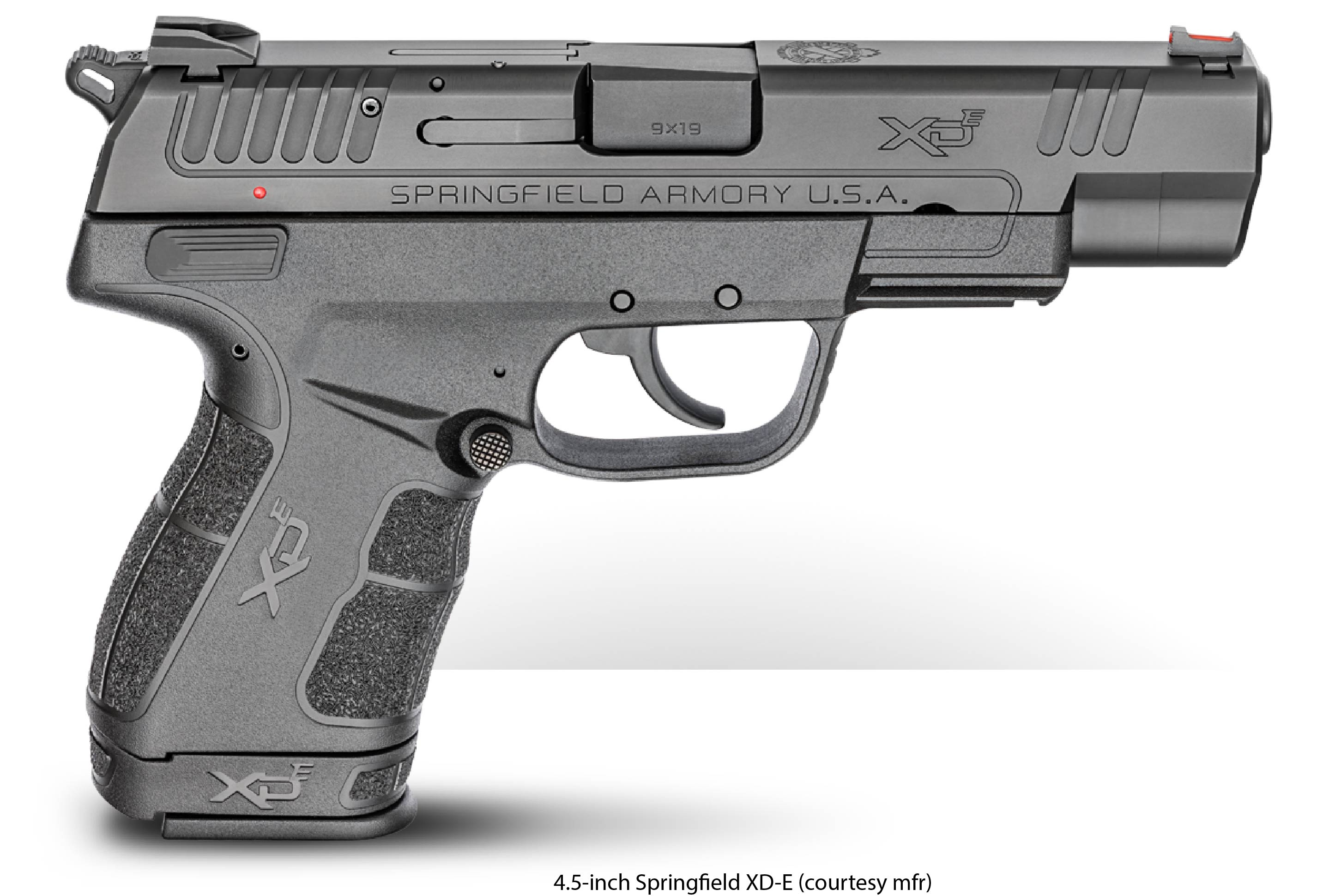
“Springfield Armory has enjoyed a strategic, collaborative partnership with the state-of-the-art factory in Croatia working hand-in-hand to develop and engineer the multiple award-winning line of XD® polymer pistols that have become staples in the US marketplace.” – Source: Springfield Armory
The XD-E™ is an extension of the XD family; whereas, the “E” stands for “External” hammer. The XD-E™ is manufactured in the city of Karlovac, Croatia by HS Produkt (formerly I.M. Metal) and imported by Springfield Armory. The XD-E™ comes in three different barrel lengths; 3.3-inch, 3.8-inch, and 4.5-inch, the latter of which I decided to develop a long-term test and evaluation period. The XD-E™, except for the 1911-based series of pistols, is the only pistol with an external hammer offered by Springfield Armory. That fact alone should have been enough to set the heart aquiver. No? Well it did mine, but that could also have been a simple case of gas.
When one is considering the purchase of a pistol in a ‘different’ configuration, there is some obvious trepidation. Hopefully, useful idiots like me will feed you enough information and guide you in your decision. So, and to start with, the Springfield XD-E™ 4.5 in 9mm is an excellent pistol. Now, and because I own several Springfield products doesn’t mean that I cannot provide an objective viewpoint of the pistol. I bring to you the good, the bad, and the ugly at my expense.
Where the Springfield XD-E™ 4.5 in 9mm fits in your scheme of things to carry or use as a home defense pistol, I leave strictly up to you. A DA/SA pistol is an excellent choice – if it fits your needs. I have had several in the past and they have served me well. So, let’s talk a bit about the Springfield XD-E™ 4.5 in 9mm.
The XD-E™ is a single-stack, polymer-framed semi-automatic pistol that comes with an 8-round magazine with pinky extension and a 9-round magazine with X-extension (a flat base plate is also included for those who prefer a flush-fitting 8-round magazine). It is a Double Action/Single Action pistol that offers three modes of carry due to its hammer, safety and trigger arrangement.
The gun can be carried with the hammer de-cocked (double-action mode) and the safety flipped up (engaged) for what some would consider the maximum safety level. Before the gun can fire, the safety must be disengaged, and the double-action trigger pressed all the way through a heavy trigger stroke distance that is just over an inch in length with a smooth, consistent 11-lb. trigger pull throughout the arc of travel. After the first shot is fired, the pistol will be in single-action mode. The single-action trigger stroke is only half an inch with about three quarters of the travel being a light take up before breaking at 4 lbs. 14.4 oz. of trigger pull (my pistol).
The next option is to carry with the hammer de-cocked and the thumb safety disengaged, counting on the weight of the double-action trigger to guard against an unintentional discharge. Now the only action required to fire is to press the heavier trigger, much like a double-action revolver.
The third method of carry is “cocked and locked,” just like a 1911. The hammer is cocked, and the safety engaged. This sets the trigger in the lighter, shorter single-action mode for every single shot.
No matter which method you choose, the pistol’s design will prevent it from going off if dropped. Except for the de-cocking feature, the action is like the CZ 75B, which can be carried in “Condition 1 – Cocked and Locked.” Except for the location of controls, the XD-E™ also reminds me of the Sig Sauer P239 single-stack 9mm and the Sig Sauer P225 (shown below); sans the weight and with a rail. The Sig Sauer P239 is no longer in production, but the P225 is currently in production.
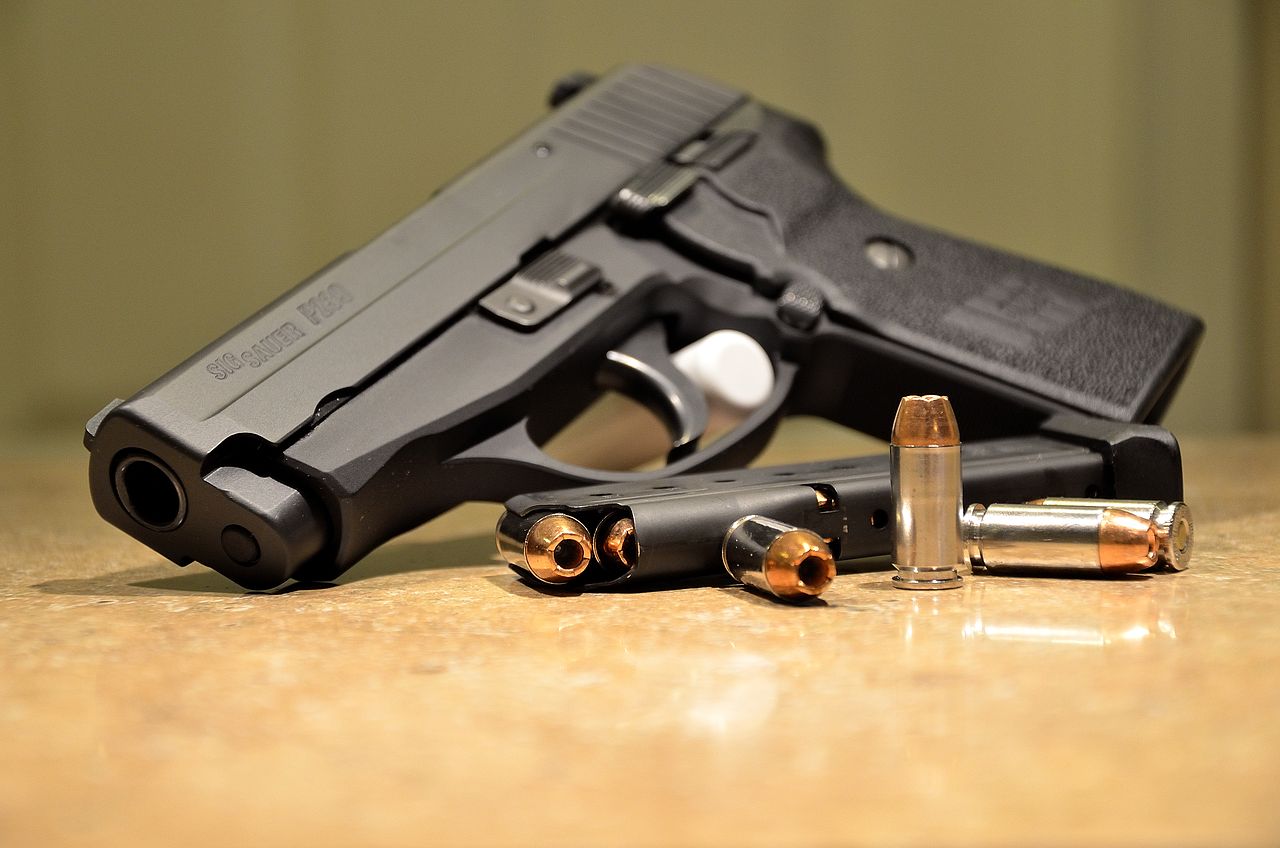
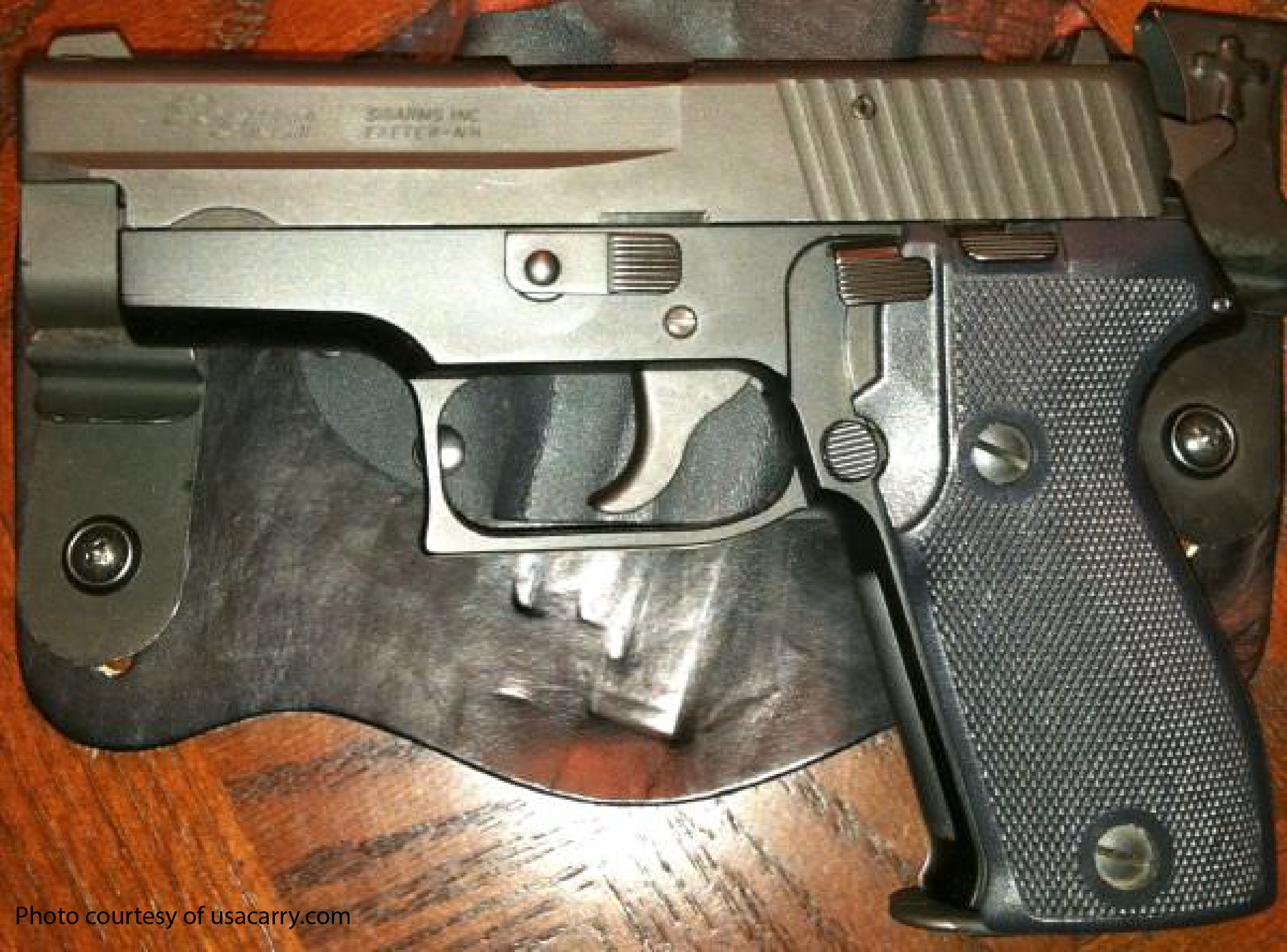
With the emphasis being on striker-fired pistols, it is refreshing to see someone still thinking about us folks that are still partial to hammer-fired pistols.
The Basics
| Caliber | 9mm |
| Recoil System | One-Piece, Full-Length Guide Rod |
| Sights | Fiber Front, White-Dot Rear |
| Weight | 25 oz. |
| Height | 5″ w/ Flush Magazine, 5.25″ w/ Magazine X-Tension™ |
| Slide | Forged Steel, Melonite® |
| Barrel | 4.5″ Hammer Forged Steel, Melonite®, 1:10 Twist |
| Length | 7.87″ |
| Grip Width | 1″ |
| Frame | Black Polymer w/ Enhanced Grip Texture, Thumb Safety w/ Integrated De-cocker |
| Magazines | (1) 8-Round, (1) 9-Round w/ Mag Extension, Stainless Steel |
| Trigger Pull | DA / SA |
| MSRP | $542.00 (source: Springfield Armory) |
The slide, as is common with the XD series of pistols, is stylized almost to the point of being too busy (in my opinion). Well-cut serrations are present front and rear for retracting the slide. A pop-up indicator at the rear of the chamber provides a means to determine that a cartridge is chambered. The front fiber sight is, of course, complimented with a two-dot rear sight that is drift adjustable for windage, as is the front sight.
Springfield Armory markings adorn the slide in their usual positions; top (Springfield Armory Cross Cannons), left (XDE-9, 4.5), and right (Serial Number behind ejection port, XDE, and Springfield Armory U.S.A.)
I would like to note about the slide styling. As shown below, on both sides of the slide, there is a line, a border if you will, that extends from the rear serrations to almost the front of the dust cover, where it takes a turn downward into the frame to a matching line that pairs up quite nicely. While it does add a busy look to the slide, it is also visually appealing.
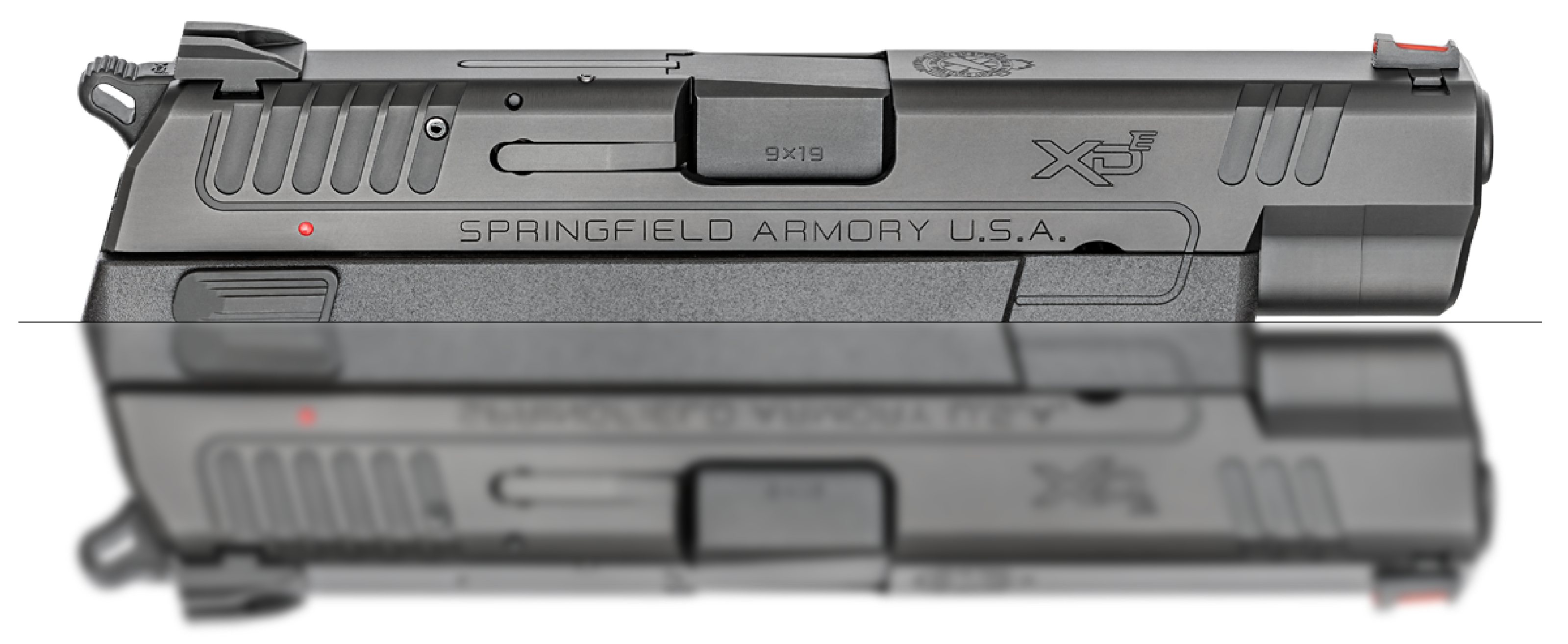
At the rear of the slide, you will see a red dot, and that red dot is the safety lever indicator. When the red dot is visible, the pistol is ready to fire. Moving the safety lever/de-cocker upward until the red dot is covered places the pistol in a safe condition. Note that the safety lever/de-cocker can be placed in the safe position regardless of the position of the hammer. If the hammer is cocked, the pistol is placed in “Condition 1.” If the hammer is down, and the safety lever/de-cocker covers the red dot, the pistol cannot be fired. If the hammer is down and the red dot is exposed, the pistol the pistol is ready to be fired in DA (Double-Action) mode.
De-cocking the hammer is disconcerting at first. With a Sig Sauer de-cocking lever, the hammer falls at a rate determined by the de-cocking lever; if you slowly lower the de-cocking lever, the hammer will slowly lower – not so with the XD-E™. The hammer falls heavily when the de-cocking lever is pressed to the de-cocking position but is blocked from contacting the firing pin.
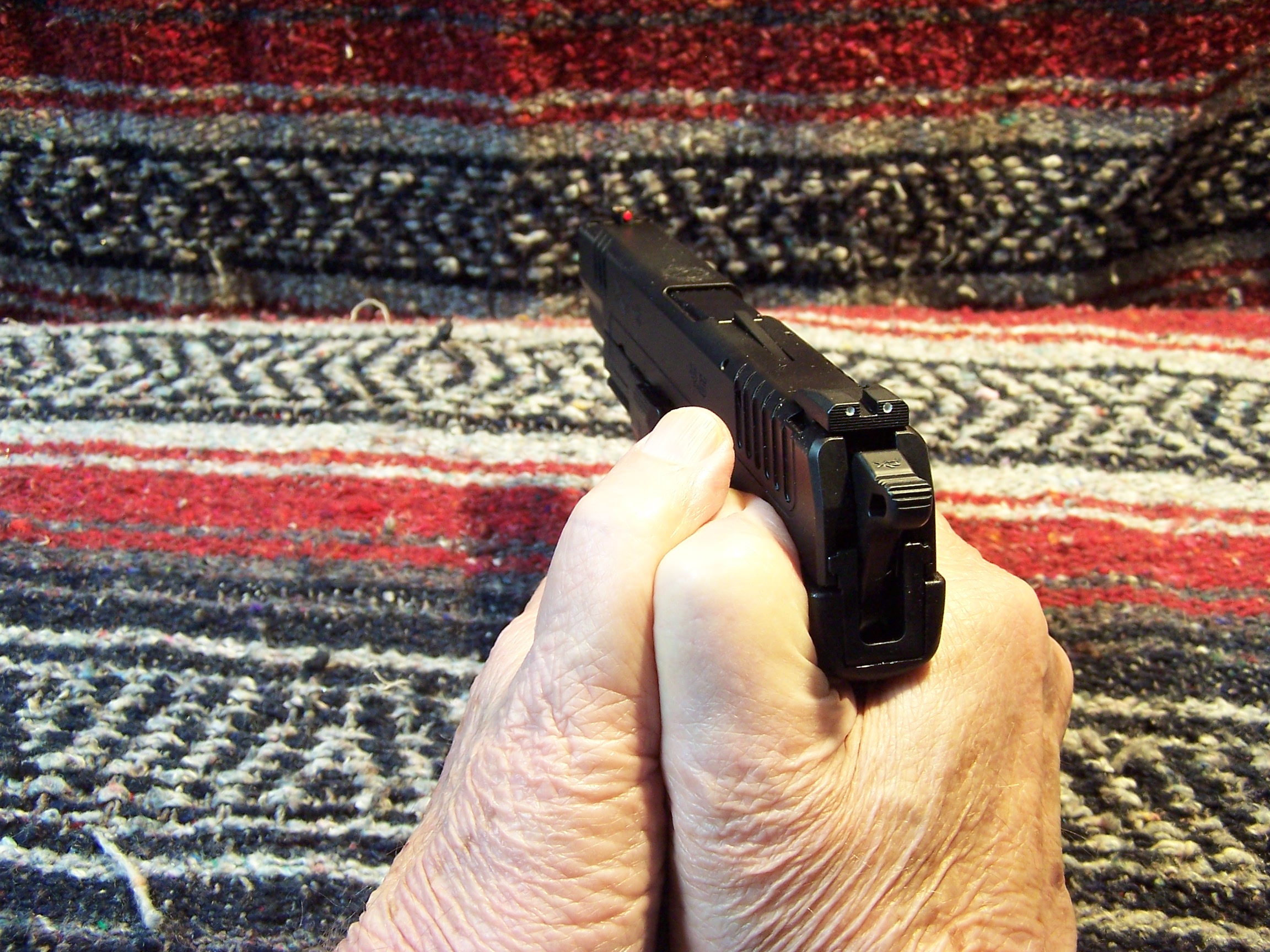
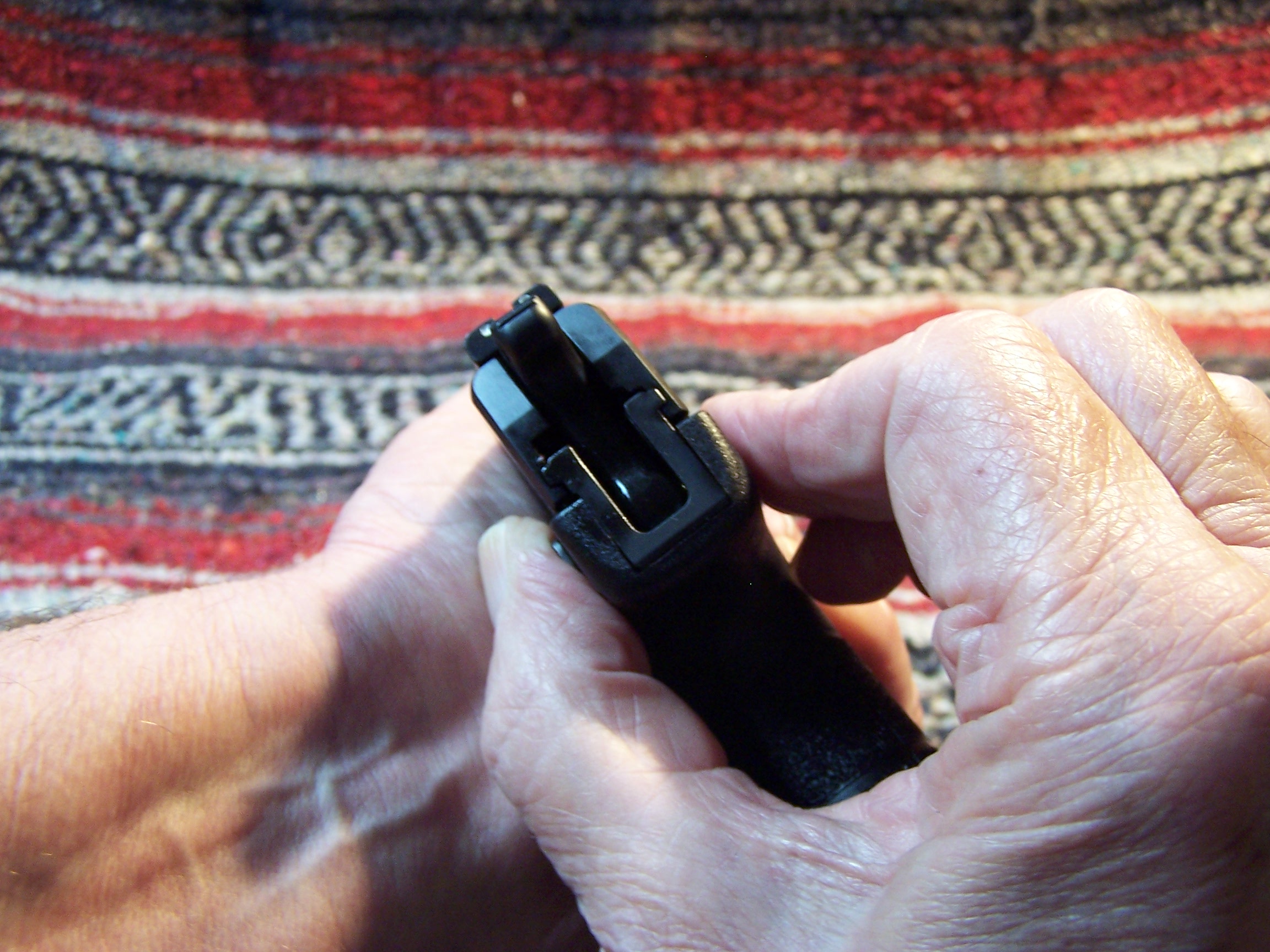
The de-cocking lever is stiff when new and required two thumbs to activate. Activating also meant changing my grip on the pistol. For my hand, the safety/de-cocking lever and the slide lock could have been swapped. As shown below, I found that if I supported the slide with my left hand, pointed the pistol in a safe direction, and then used the thumb and trigger finger of the right hand to press down, or pull down, the de-cocking lever, the de-cocking process became easier. Still, this is not a preferred method.
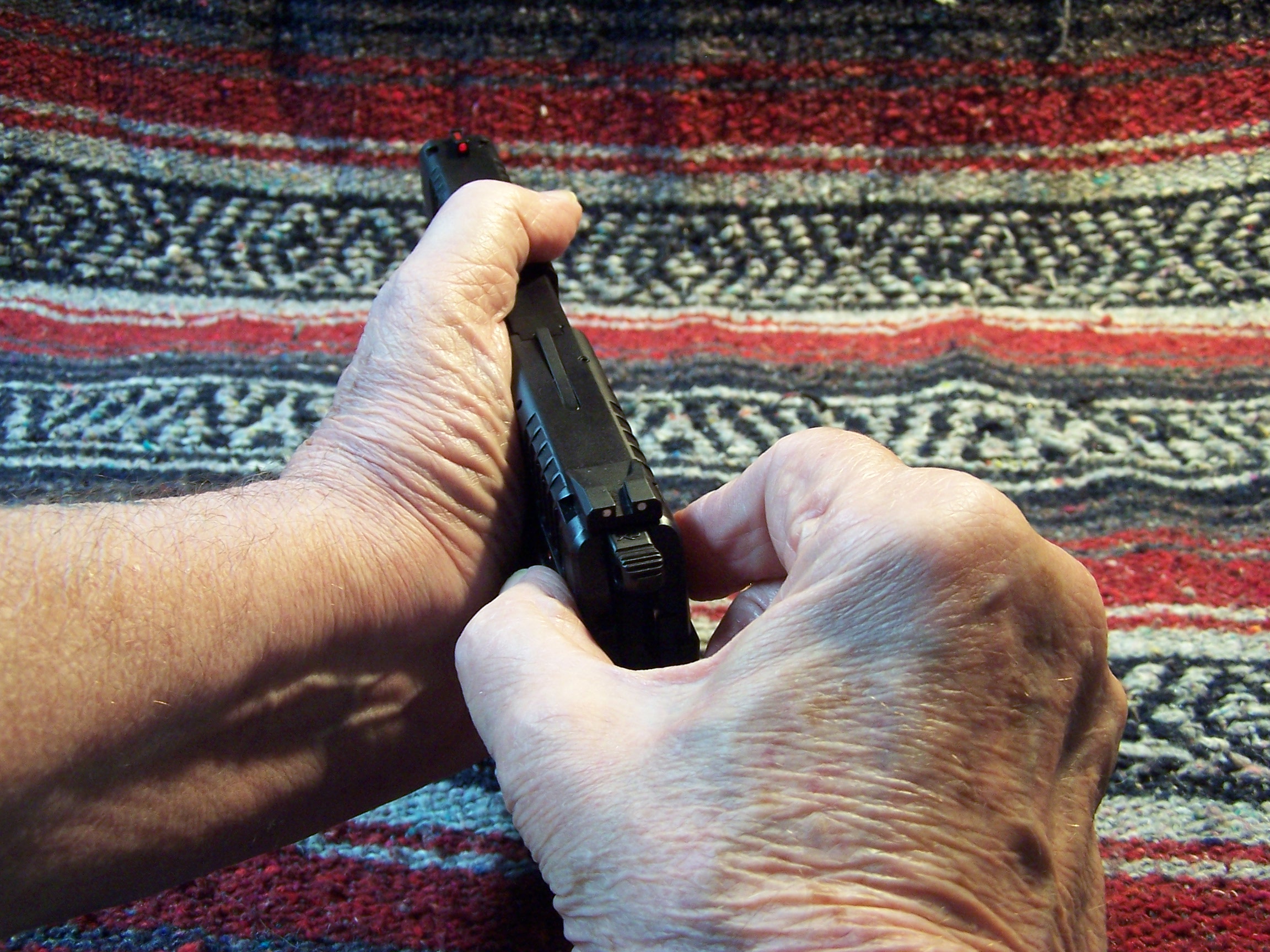
As the de-cocking lever is breaking-in after numerous times of using it to de-cock the hammer, it is slowly becoming a one thumb-operating de-cocker. With that said, I will continue to use the time-honored method of pointing the pistol in a safe direction, grasping the hammer with the fingers of my support hand, and then controlling the descent of the hammer to the hammer block as I pull and release the trigger. This is not an uncommon method to use for those who run a 1911 pistol or for those who simply distrust de-cockers.
The XD-E™ 4.5 9mm feels ‘Slide Heavy’ to me without a magazine installed. A full magazine; however, balances the pistol out a bit, but it is still a tad ‘Slide Heavy.’ It should be obvious that most of the pistol’s weight is with the slide assembly. Both magazines (8-round with pinky hanger and 9-round with X-tender) provide some bottom gripping real estate. Both magazines accomplish the same thing but in different ways.
Not mentioned by Springfield Armory is the pistol’s ‘second-strike’ capability when in DA mode. If a primer fails to ignite, the trigger can be pulled again (assuming the pistol is not out of battery). If the primer then ignites and a projectile is sent downrange, the pistol is set to SA mode. If the primer still does not ignite, the slide needs to be cycled to chamber another cartridge; whereas, the pistol would be placed in SA mode. However, the user should also be aware of a couple of conditions called duds and hang fires.
“A dud (a misfire or failure to fire) occurs when the trigger is pulled but the primer or powder in the cartridge malfunctions, causing the firearm not to discharge. Dud rounds can still be dangerous and should be deactivated and disposed of properly.
A hang fire (also delayed discharge) is an unexpected delay between the triggering of a firearm and the ignition of the propellant. Whenever a firearm fails to fire, but has not clearly malfunctioned, a hang fire should be suspected. When this occurs, the correct procedure is to keep the firearm pointed downrange or in a safe direction for thirty to sixty seconds, then remove and safely discard the round (which is now a dud as explained above if the primer was struck, otherwise the gun itself may have malfunctioned). The reason for this is that a round functioning outside of the firearm, or in the firearm with the action open (out-of-battery discharge), could cause a serious fragmentation hazard.” – Source: https://en.wikipedia.org/wiki/Firearm_malfunction
According to Springfield Armory, “The design features a Low-Effort-Slide that requires 27% less effort to cycle the slide when compared to leading striker-fired pistols in its category.” The slide on this pistol is quite easy to manipulate.
The extractor is, of course, external and it does a fine job of pulling spent cases from the chamber.
The frame is nicely done and textured in all the right places. The “Grip Zone” labelling has been removed from the 4.5” model and the grip area texturing is aggressive enough to provide a firm gripping surface without being abusive to the hand for most people. I; however, find the texture to be a tad on the light side and would like a bit more aggressive texturing. The grip width is 1-inch as compared to the XD-S grip at .975-inch” and a typical 1911 grip width at 1.270 inch. The grip circumference is on the thin side, but for me there is an answer; the new Springfield Armory XD-E 9mm/.45ACP: HandALL Beavertail Grip Sleeve – Black Sku: 17310 from Hogue, as shown below.
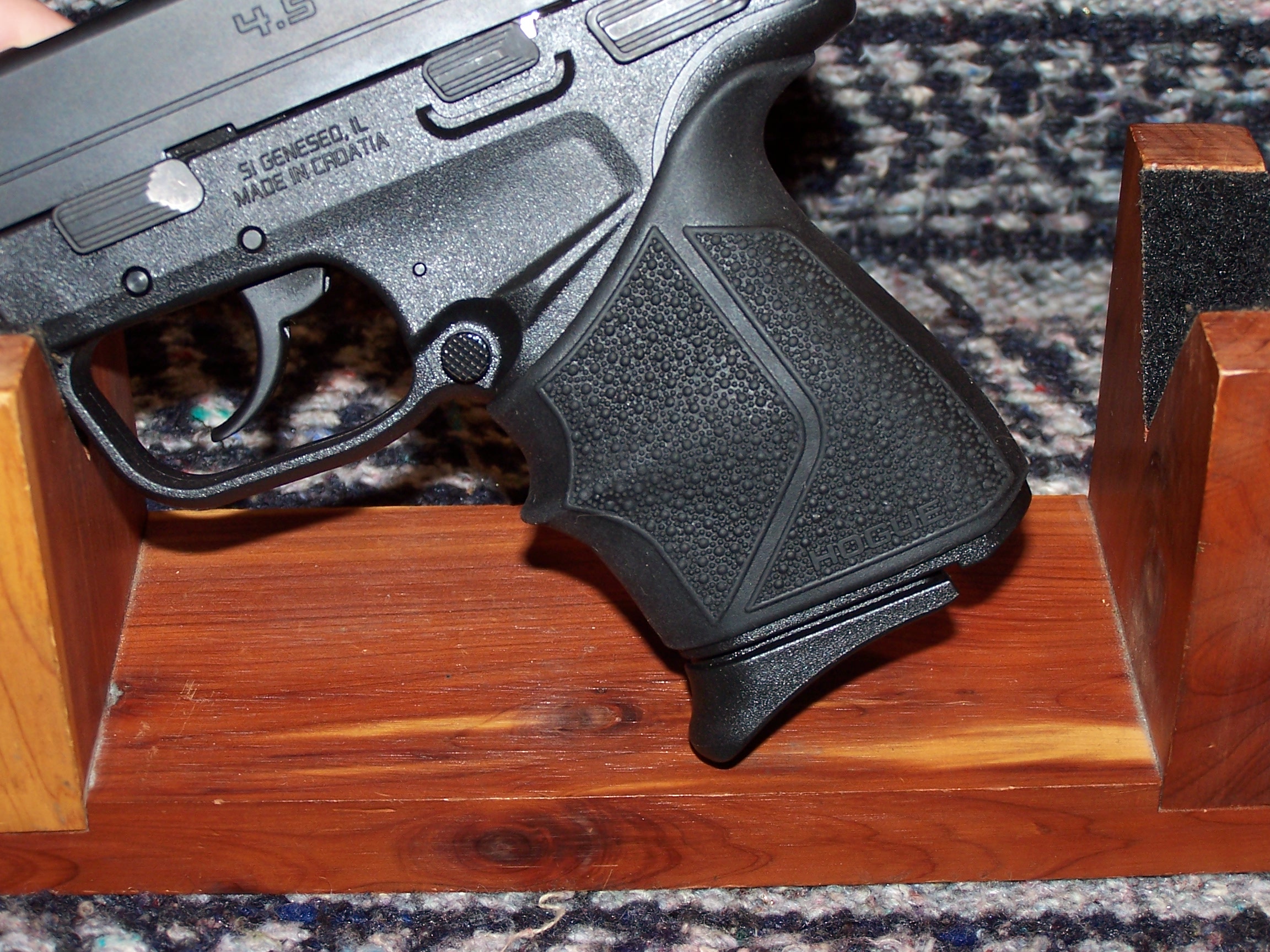
The Hogue Handall grip sleeve provides a better gripping surface than textured polymer, which I find the feel of polymer to be slippery in my hand and the grip sleeve mitigates that. A palm swell presses the grip right into the palm of the hand. The grip sleeve also adds bulk to the small finger groove of the pistol’s grip, which helps my middle finger to slide right up under the undercut of the trigger guard and which allows all fingers to be on the grip. Using the 9-round magazine does not add an appreciable amount of real-estate to the grip area. The Hogue Handall enhances the grip and the ameliorated recoil is always welcomed in these hands. Installation took less than five minutes using some window cleaner inside the sleeve and massaging the grip sleeve onto the grip of the pistol. No heat was applied, as the grip had been sitting in the mailbox for over an hour in 95-degree heat.
There is a thumb groove on both sides of the frame, and just below that thumb groove is the ambidextrous magazine release button. I find it very easy to use the thumb or trigger finger of the shooting hand to release magazines. It is just the pistol’s ergonomics at work.
Like most XD series pistols, the bore axis is high, but that does not seem to affect the performance of this little guy. Well, I can’t say little, really. With a 4.5-inch barrel, the XD-E™ would be in the “Commander” class of 1911 pistols, and the 9+1 magazine capacity (with extension) follows my “Commander” assessment. It is my opinion that the default capacity should have been 9+1 without the extension, as is common for a 9mm pistol of this size, had the capacity been thought through thoroughly by Springfield. Although carrying the pistol with the 8-round magazine will suffice in most cases, most users will carry the pistol with the 9-round magazine, because there is little difference in height between the two provided magazines.
The grip angle is close to that of the 1911 pistol and has a nice beaver-tail that helps you get your hand as high on the back-strap as possible. Obviously, the rear of the XD-E™ is quite a departure from that of other XD-series pistols that are striker-fired; the “cocking” indicator is the exposed hammer. There is no grip safety, as the latter is not needed with the safety/de-cocker feature, and there is no trigger safety (internal to the trigger) except to keep your finger off the trigger until you are ready to shoot.
Take-down is straightforward and does not require pulling the trigger or using special tools to remove the slide from the frame.
CAUTION! The XD-E has a captive guide rod and spring assembly, which is under tension, and care should be taken when removing it from the slide.
- Ensure that the pistol is unloaded and safe.
- Retract the slide to the rear and secure with the slide lock lever.
- Push the takedown lever up.
- While grasping the slide, push the slide lock lever down to release the tension on the slide.
- Slowly remove the slide from the frame.
- Remove the captive guide rod and recoil spring assembly from the rear of the slide.
- Remove the barrel from the slide from the rear.
Several lubrication point are identified, and lubrication actions recommended:
- Field Strip pistol. Only remove slide from frame
- Using any quality firearm lubricant, 1 drop of lubricant on each side of the rear slide railways.
- Reassemble slide to frame.
- Manipulate slide back and forth 5 – 10 times.
- 1 drop of lubricant on chamber area of the barrel
- Lock slide to the rear.
- 1 drop of lubricant on the top of the muzzle of the barrel, 1/4” from front top of muzzle and inside wall of slide.
- Manipulate slide back and forth 5 – 10 times.
Range Time
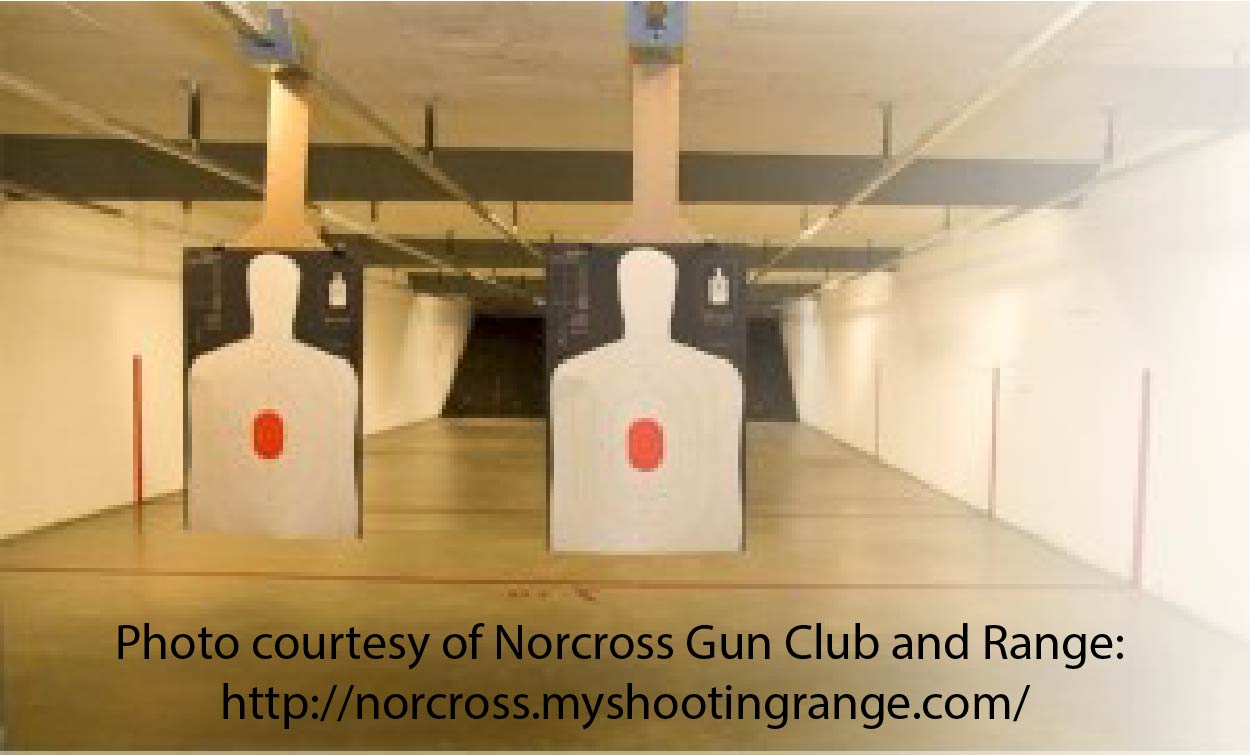
It all boils down to how well the pistol will perform. Regardless of how compact a pistol is, or how great it looks or feels in the hand, it all comes down to how it performs.
My evaluation ammunition consisted of my standard Sellier & Beloit 115-grain FMJ, Sig Sauer V-Crown 124-grain JHP, and Sig Sauer V-Crown 147-grain JHP. I try to use this ammunition consistently, as I know how it performs in my 9mm baseline firearm (a Rock Island Armory 1911 FS 9mm Tactical), and I judge the performance of this ammunition in other firearms against the baseline.
Setting a silhouette target some seven yards away, the test for function was begun with a secondary test for accuracy and the ability of the pistol be true to my POA, given the ammunition being used. The first five Sellier & Beloit 115-grain FMJ were fired from a rest in SA mode to compare POI to POA. With those results in my head, the remaining forty-five cartridges are fired off-hand from my favorite “Modified- Modified Weaver” stance for function, which is followed up with a few defensive cartridges for comparison. If this first session checks out, I’ll run a few drills in later session. However, there was one exception to my rule for this first session.
Since I was working with a different trigger system than is my normal, and since it has been quite a few years working with a DA/SA trigger, I decide to run a couple of “Mozambique Drills” beginning in the DA mode. My version of this drill starts in the “low ready” position, as the range is not comfortable with folks drawing from the holster, even if they have been trained to do so (it’s a liability thing).
I do not use a timer, so at some trigger point in my brain I try to get the front end of the pistol at center mass, pump two rounds into it, and then pump that third round to the head. The first shot is, of course, double-action and it does take longer. With the Springfield XD-E™, I was trying to begin my trigger pull as I was coming out to bear on the desired POA while trying to establish a flash sight picture. With proper timing, I can be at the “staging point” of the trigger where, once I re-establish my sight picture, it is but a short pull to drop the hammer. I must admit that I am not fully confident yet in working this method, but if I was to carry the XD-E™, I would have to perfect it. Here is where old training starts to kick in.
When I was a LEO in a past life, the Sig Sauer P220 was my constant on-duty service piece after the department made me retire my primary service pistol, a Colt Series 80 Government Model that the department felt was unsafe to carry. That Sig and I spent many hours of dry trigger time working this method and I became quite proficient at it, at least to the point where the range officer did not admonish me for “stacking” the trigger. Those old motor skills had to be brought back from the oblivion to where they were sent after I left that line of work. Several hours of dry-fire practice with the XD-E™ at least got me to the point to where I thought that I could do this again.
Needless to say, the transition from double-action to single-action is not quite ready for prime time. With that said, I was able to place shots pretty close to where I wanted them both at center mass and head regions.
If you are not used to a DA/SA pistol, the trigger transition can be a bit intimidating. Even if you are used to a DA/SA pistol, that first DA shot still takes some concentration. After my first “Mozambique” session was over, I shot a mag-full in DA mode to get more used to the trigger (and to continue breaking in the de-cocker lever). The second mag was shot DA first shot and subsequent shots were SA. The double-action trigger feels as if it will never release the hammer, as the pull is long (in comparison to a single-action trigger).
The trigger is highly curved and seems to trap the finger right in the trigger shoe, which is rounded and smooth. While in SA mode, the trigger finger seems to follow a straight-back path of travel. In DA mode; however, there is a tendency to the trigger finger to pull down on the trigger as the trigger is pulled rearward. Because of the long DA trigger pull, this tendency is common, as the same thing can be found with double-action revolvers. A smooth, continuous rearward trigger pull is essential.
While I previously mentioned a “staging point”, there is no staging point, per se, with the DA trigger, and one can simply pull it through the complete stroke whilst keeping the sight picture steady. However, one can learn to ‘stage’ (otherwise known as “stack’) the trigger and with practice I am learning to do just that; pull the trigger back to a point where I could hold it, re-establish (if necessary) my flash sight picture, and then continue the pull until the hammer releases. You will have to find your own “staging point’ because it will probably differ from mine. (Note that you can back off the trigger at any time during the trigger stroke; wherein, the action returns to DA mode.) There is a bit of over-travel, and this is common with this type of trigger. Once released, the reset is a bit more forward than you may be used to. Nonetheless, the rest of the shots will be in single-action mode until the magazine is empty or you decide to stop shooting, whichever comes first. The single-action trigger pull is also long, but not nearly double-action mode long. There is quite a bit of take-up before the ‘wall’ is felt. From the ‘wall’ is a short but smooth transition until the hammer falls and when the magic happens. Single-action trigger pull weight for this pistol is 4 pounds, 14.4 ounces.
The safety/de-cocker is very stiff when moving into the de-cocking position. Placing the pistol in DA mode took two thumbs on the left de-cocking lever. The contour of the safety/de-cocking lever seems to have enough real estate at first glance. However, the thinness of the grip and the compact nature of the pistol does not make it easy to work the lever, at least for me. Once the hammer is de-cocked, the safety/de-cocking lever automatically returns to the fire position. Because of the spring tensioned de-cocking lever, I did not have to concentrate on taking the safety out of safe mode in Condition 1 carry so that I did not inadvertently move it to the de-cocking position. The safety lever moves in and out of the safe position very easy after some operation. The hammer, of course, can be cocked at any time, and there is plenty of hammer to do so with its roiled and serrated spur.
Placing the hammer in double-action mode can be accomplish in the time-honored and proven method of grasping the hammer with the left thumb and forefinger (for right-handed shooters), then pulling and releasing the trigger while slowly lowering the hammer to the DA mode position. You will feel the trigger reset in DA mode. The hammer falls into the de-cock notch and operates from that point in DA mode.
The safety/de-cocking lever is not the widest and comparing it to the thumb safety on a 1911 pistol reveals little difference in size and position on the frame of the pistol. The only thing that I can say is that it will take a bit more practice drawing the XD-E™ from the holster to obtain the correct timing and control of the safety lever that it would for a 1911.
There is only one pistol that I totally trust to be carried in Condition 1 and the XD-E is not one of them, nor is the CZ-75B. Therefore, the XD-E™ would be carried in the DA condition. I have worked with Sig Sauer, Bersa, Beretta, and other pistols enough to be totally comfortable with DA/SA operation. All it takes is trigger time. That’s not saying that I don’t trust the XD-E™, or the CZ-75 DA/SA firearm. It is saying that, for me, I am more comfortable with the 1911 in Condition 1. And it is saying that I prefer to carry the Springfield XD-E™, the Beretta 92FS, the Sig Sauer DA/SA pistols, the Bersa DA/SA pistols, or other DA/SA pistols in DA mode wit safety/de-cocker in the off position.
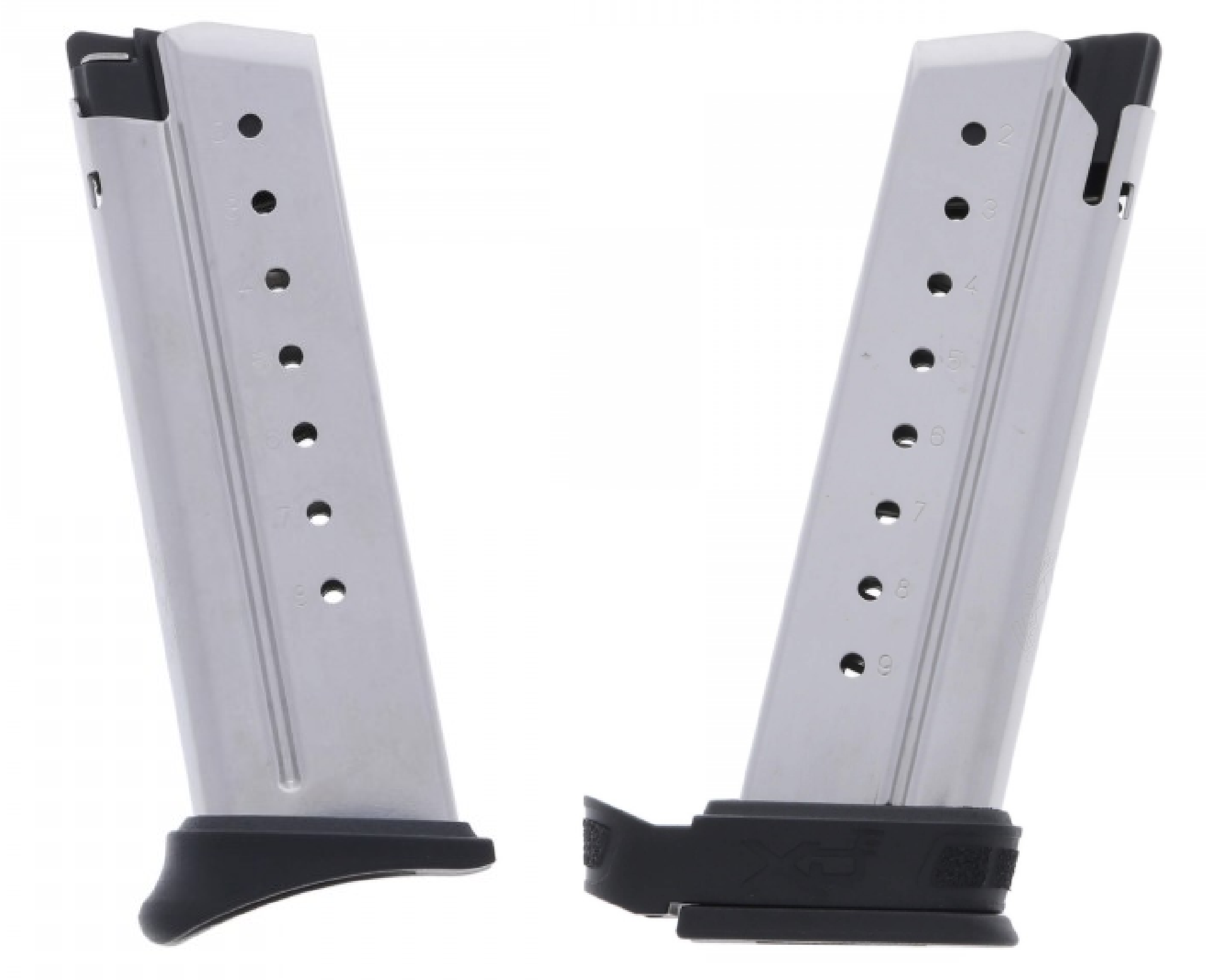
Both magazines supplied with the XD-E™ 4.5 worked fine. The magazines are not cheap, however. Through gunmagwarehouse.com. the Springfield Armory XD-E 9mm 8-Round Flush-Fit Magazine w/ Finger Extension will cost $35.99 (shown on left above), while the Springfield Armory XD-E 9mm 9-Round Factory Magazine w/ X-Tension Sleeve (shown on right above) will deplete $32.99 per magazine from your bank account. The 8-round version is a good default carry magazine and I will order a couple of the 9-round magazines for spares. Personally, I like the ‘pinky rest,’ as it gives my little finger a ‘pulling point’ when removing the pistol from the holster. If you don’t care for the ‘pinky rest’ a flat (flush) base plate is provided with the pistol (a DIY change) or you can purchase the Springfield Armory XD-E 9mm 8-Round Flush-Fit Magazine for $27.99 through gunmagwarehouse.com. I have no affiliation with gunmagwarehouse.com; they are just a resource.
The Springfield XD-E™ 4.5 performed flawlessly with anything loaded into it. Chambering cartridges is no problem, as the highly-polished feed ramp ensures their smooth insertion and the Springfield XD-E™ 4.5 seems to have a voracious appetite for any 9mm cartridge. Extraction and ejection of those spent shell casings are just as positive.
The weight of the pistol helps in the felt recoil department. I was feeling the recoil in the web of my hand and felt that I was in control of it rather than it being in control of me. The felt recoil is mild and manageable. The new Hogue Grip Sleeve added a bit more cushion, aided in recoil management, and made the pistol more pleasurable to shoot.
Hammering it Home!
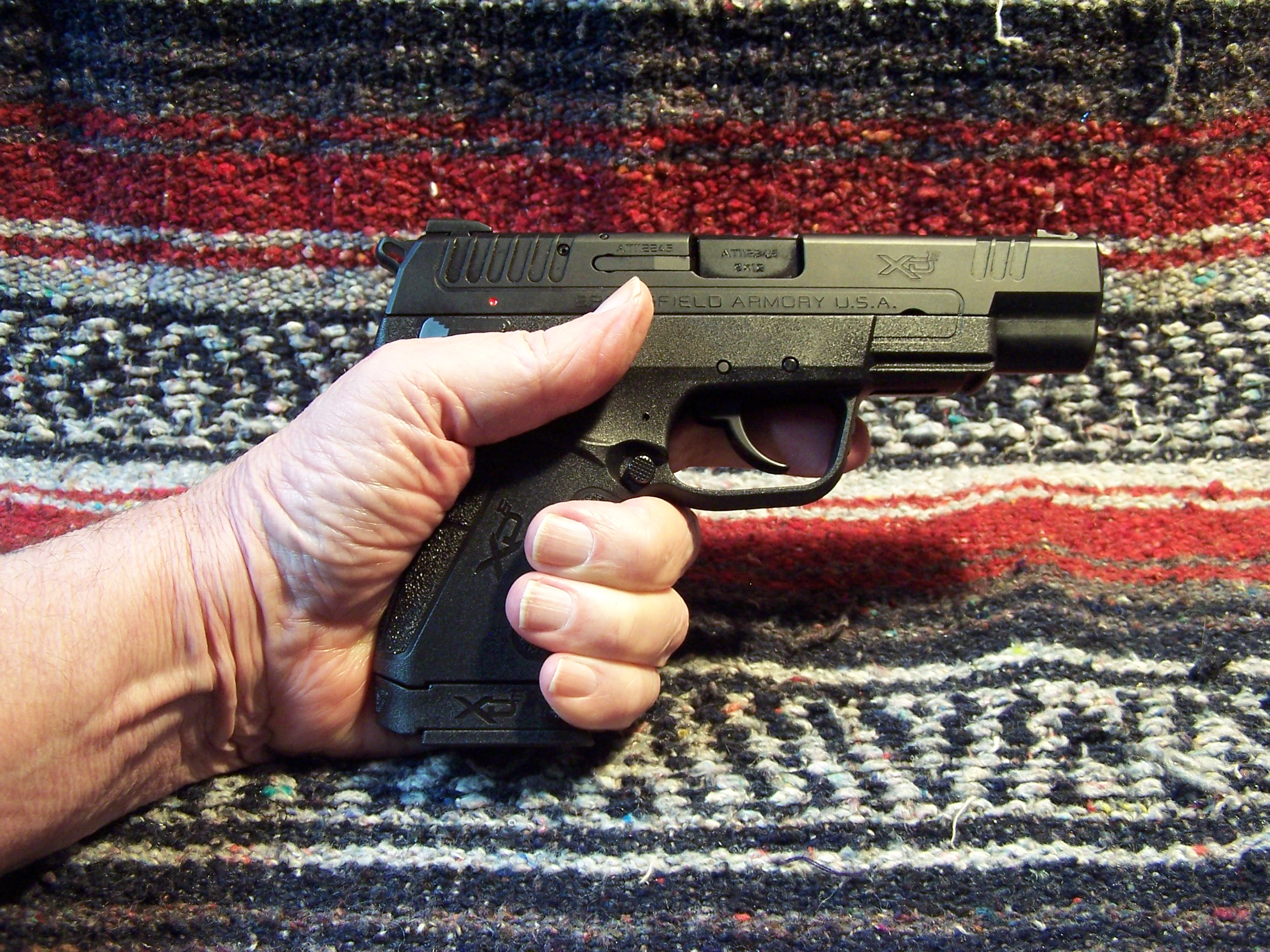
The bullet striking the target is the culmination of a series of events, the pistol’s denouement if you will. And the XD-E™ 4.5″ SINGLE STACK – 9MM (XDE9459B) works very well.
It has been said that one you shoot one Glock you can shoot any Glock, primarily because the triggers are much the same on all “out-of-the-box” Glock pistols. With some experience with the Springfield line of XD pistols, the same could be said about the XD pistols. With very few variances, the same could be said about 1911 triggers, but then there are good 1911 triggers, very good triggers, and most excellent 1911 triggers. And, then there is the XD-E that comes along to harsh the trigger status quo with its DA/SA trigger.
With its 4.5-inch barrel (a slight gain in velocity and sight radius over a shorter barrel and slide), compact size, light weight, and up to 9+1 round capacity, it is hard to come up with an excuse not to carry the XD-E™ 4.5″ SINGLE STACK – 9MM (XDE9459B), let alone its shorter brethren. While the DA to SA transition might put some off, that is not a fault of the pistol, but more personal in nature, and the nuances of a DA/SA trigger can be overcome with training and trigger time. I became very efficient of working the manual of arms on my Sig Sauer P220 .45 ACP, the Sig Sauer P239, and Sig Sauer P226; all DA/SA pistols – the XD-E™ 4.5″ SINGLE STACK – 9MM (XDE9459B) will be no different.
Consisting of 66 separate parts, and weighing 25 ounces empty, a pistol like the XD-E™ 4.5″ SINGLE STACK – 9MM (XDE9459B) would be an excellent carry and the “Cuda” holster from Simply Rugged Holsters, like that below, would be an excellent concealed carry holster. (Author’s Note: The ‘Cuda’ holster shown is for the XD-M™ 4.5 in multiple calibers. It just so happens that it works with the XD-E™ as well.) The XD-E™ 4.5″ SINGLE STACK – 9MM (XDE9459B) also fits perfectly in my Galco Classic Light shoulder holster for the Sig Sauer P239, although Galco does make this holster specifically for the XD-E.
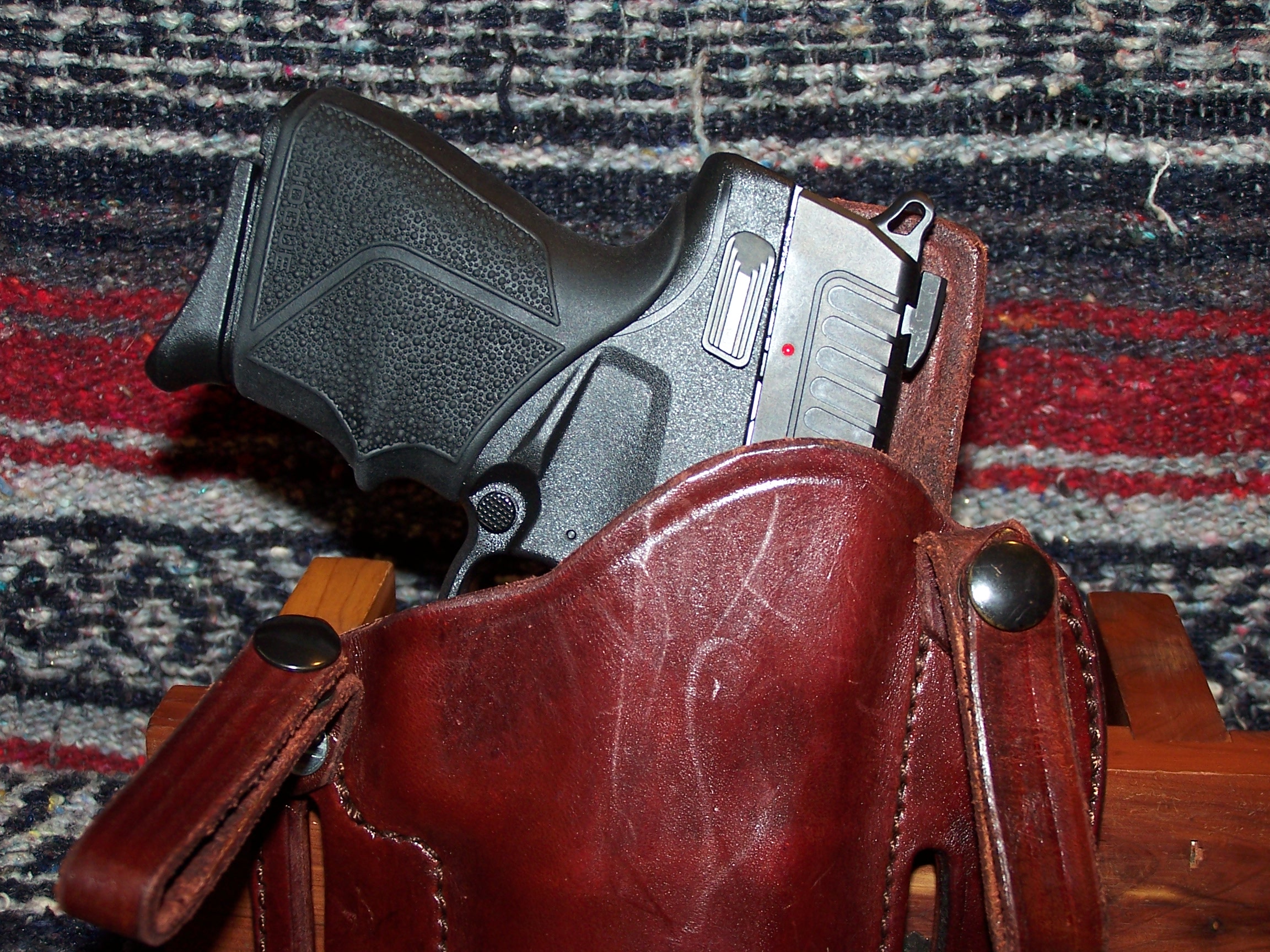
In trying to keep the “one holster – one pistol” mentality going, I once again turned to Falco Holsters to provide me with the A112 Hawk holster that is for an XDM 9mm 4.5, because one for the XD-E™ in 4.5 is not available at the time of this writing, and dimension-wise they are about the same.

XD-E™ 9mm 4.5 in Falco A112 Hawk IWB Holster
The width of the XD-E™ is 1.0 inch (at the controls) and the XD-M™ 9mm in 4.5 is 1.18 inches, and with a leather holster that needs a break-in, it means that the Falco A112 Hawk will work perfectly for the XD-E™ 4.5. Note that a ‘sweat guard’ is not part of this holster. As with a 1911 that has a thumb safety, the sweat guard of the Falco A112 Hawk for the XD-E™ also has no sweat guard that could interfere with safe operation. Not having a sweat guard may rub some people the wrong way, or should I say that the grip of the gun would rub some people the wrong way, but not having a sweat shield is my preference – and a t-shirt protects my precious self from grip rub. With that said, I am comfortable carrying the XD-E™ in DA or Condition 1 modes, with the former being the preferred method.
I would have no qualms carrying the XD-E™ 4.5 9mm for personal protection, after some more quality time with the trigger, safety lever, and de-cocking mode operations. The XD-E™ 4.5 in .45 ACP would make a nice carry in that caliber but is not available at the time of this writing. Currently, the XD-E™ in .45 ACP is only available in the 3.3-inch barreled version, but if one comes available in a 4.5-inch version, well…
Lastly, if you have never handled a DA/SA pistol before, the pistol will feel like an odd duck compared to the many striker-fired pistols already in a saturated market. The reason that I purchased the Springfield Armory XD-E™ 4.5 9mm was because it is an odd duck pistol that had been said to be a hammer-fired Glock G48. But, the Springfield Armory XD-E™ 4.5 9mm stands on its own merits. Between you and I, the Glock G48 and the Sig Sauer P225-A1 feel much better in my hand, but that’s a topic for a different discussion. The Springfield Armory XD-E™ 4.5 9mm is a pistol for those who like something different but also need a reliable and accurate pistol for self-protection. Por el precio, no se empapará.
Author’s Note: Close competitors to the XD-E™ 4.5 in 9mm, that I can tell, would be the hammer-fired HK USP V1 9mm 4.25″ Barrel 10 Rounds Polymer Frame Black and the Sig Sauer P225-A1 Nitron Compact.
For the MSRP of $542 asking price, the Armory XD-E™ 4.5 9mm is an affordable and excellent pistol that, like many, has a few quirks to work through. The HK USP V1 carries a MSRP of $999, whilst the Sig Sauer P225 lists out at $1,032. (Author’s Note: All MSRPs are as listed on the Davidson’s Gun Genie website.)
Stay tuned, as there will be a comparison between the Springfield Armory XD-E™ 4.5 9mm, the Glock G48, and the Sig Sauer P225-A1 coming at some point.
Personal Upgrades
For my use, there are two personal upgrades for this pistol; (1) the Springfield Armory XD-E 9mm/.45ACP: HandALL Beavertail Grip Sleeve – Black Sku: 17310 and substituting the default sighting system with a night sight setup yet to be determined.
Resources:
- XD-E™ 4.5″ Single Stack – 9mm: https://www.springfield-armory.com/products/xd-e-4-5-single-stack-9mm/
- Springfield XDe: https://www.youtube.com/watch?v=EhJTl9QOhIs
- Springfield Armory XDe Tabletop Review and Field Strip: https://www.youtube.com/watch?v=oizi21L3pRM
- NRA Gun of the Week: Springfield Armory XD-E Pistol: https://www.youtube.com/watch?v=7otreSk4bRw
- For information regarding the HS2000, the parent of the XD series of pistols, click here.
- Striker-Fired vs. Hammer-Fired: What’s the Real Difference?: https://blog.cheaperthandirt.com/striker-fired-vs-hammer-fired/
![]()

